When you hear the word shark, either a cartoon or a real-life experience may pop into your head. But one thing you probably did not know about sharks is that there are around 400 different species of sharks, and the blue shark is one of them. The blue shark or the Prionace glauca is one of the not-so-scary sharks out in the oceans. But the bad part is that they are slowly becoming less and less in terms of their population size. This is because they become victims of pollution and industrial waste. This animal is pretty amazing in many different ways. Let’s look at a few of the different blue shark facts we found.
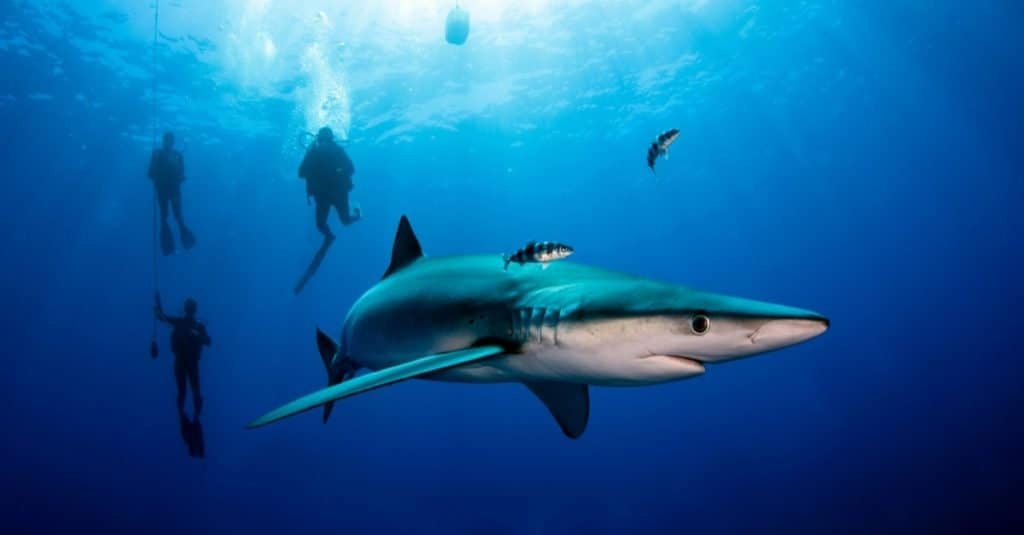
The blue shark is one of 400 species of shark.
©Vladislav Klimin/Shutterstock.com
10 Incredible Blue Shark Facts

#1 They Are Found Almost Everywhere in the World
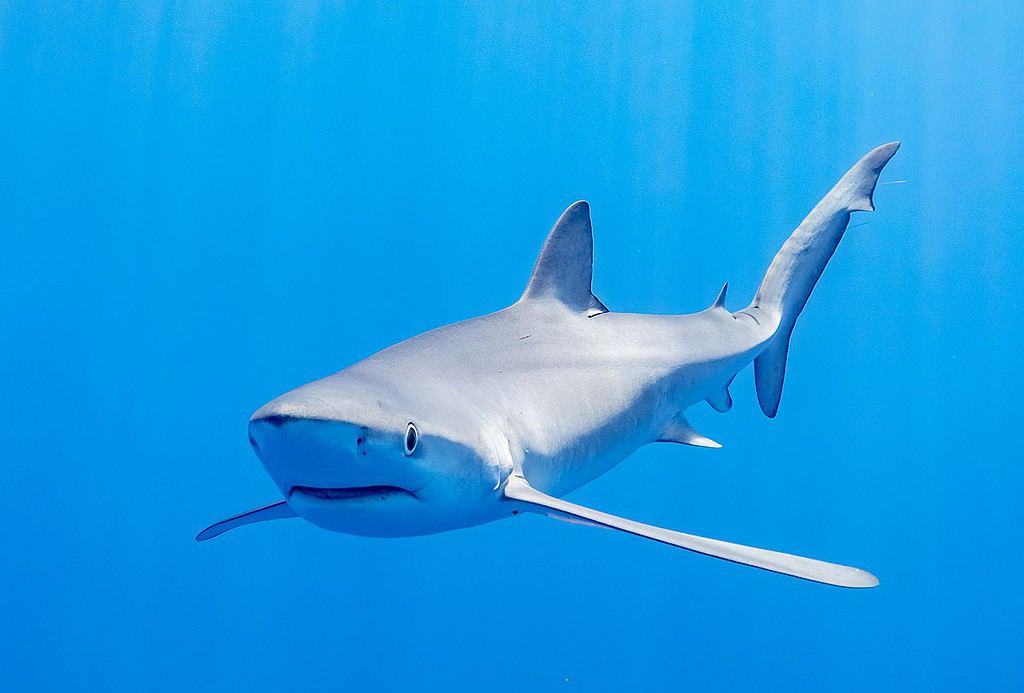
From the northern parts of Norway to the South, far off in Chile, the blue shark can travel great distances.
©Diego Delso, CC BY-SA 4.0 – License
If you take a look at all the shark species in the world, you will find that most of them are present in the depths of the ocean. But the blue shark is unlike most as it can be seen in open waters just near the surface.
In addition, you can spot them anywhere in the world. From the northern parts of Norway to the South, far off in Chile, the blue shark can travel great distances. They follow this long route in the hopes of food and cold or temperate waters. They are found in every continent’s coastal area, swimming across the sea in depths of a mere 1000 to 1100 feet. However, they can dive further into the sea for food.
#2 They Feed All Day Long
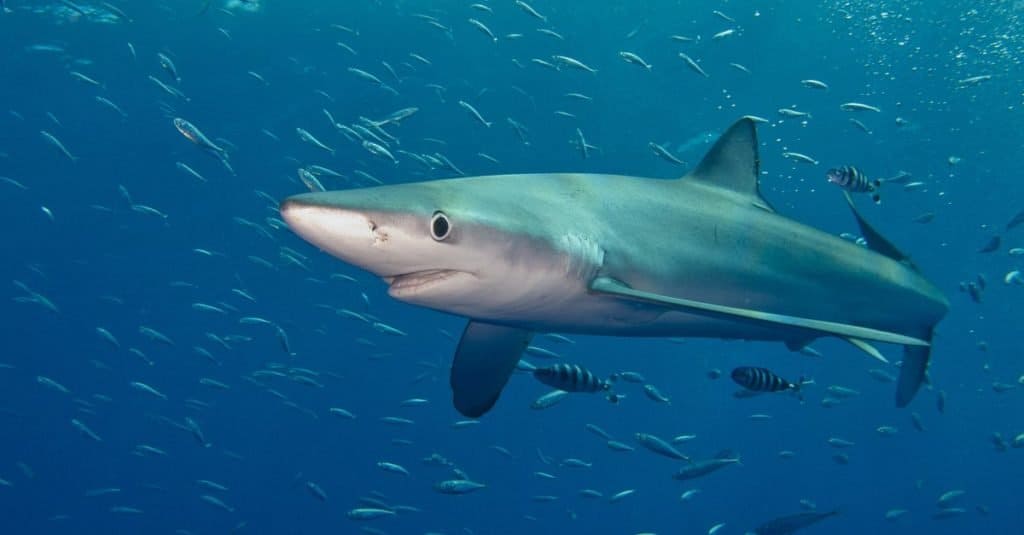
A Blue shark’s diet consists of pelagic fish such as cod, herring, pollock, tuna, butterfish, and swordfish.
©Anna L. e Marina Durante/Shutterstock.com
As you now know, they can travel great distances for food. Hence, it is safe to say that they are fond of satisfying their appetite. Their diet consists of pelagic fish such as cod, herring, pollock, tuna, butterfish, and swordfish. They also enjoy eating various smaller marine animals like lobsters, crabs, smaller sharks, shrimp, and even sea birds. But the meal they appear to gobble up the most is the squid.
Yes, even the slippery squids do not stand a chance against these predators. Although they are found well below the 1000-foot mark, the blue shark will dive 1500 feet straight into the ocean if they spot the dancing prey.
#3 They Have A Lot of Babies

The most amazing thing about their reproduction is their litter size.
©Damocean/ via Getty Images
Did you know one blue shark produced 135 babies at once?
Since they are Viviparous animals, they give birth to offspring after keeping the babies in their bodies for a specific time. The gestation period is somewhat similar to humans as it is 9 months. But it could run for 12 months as well. The most amazing thing about their reproduction is their litter size, which is no joke. They are known to produce 5 to 100 babies in one reproduction cycle.
#4 They Are Not Entirely Blue
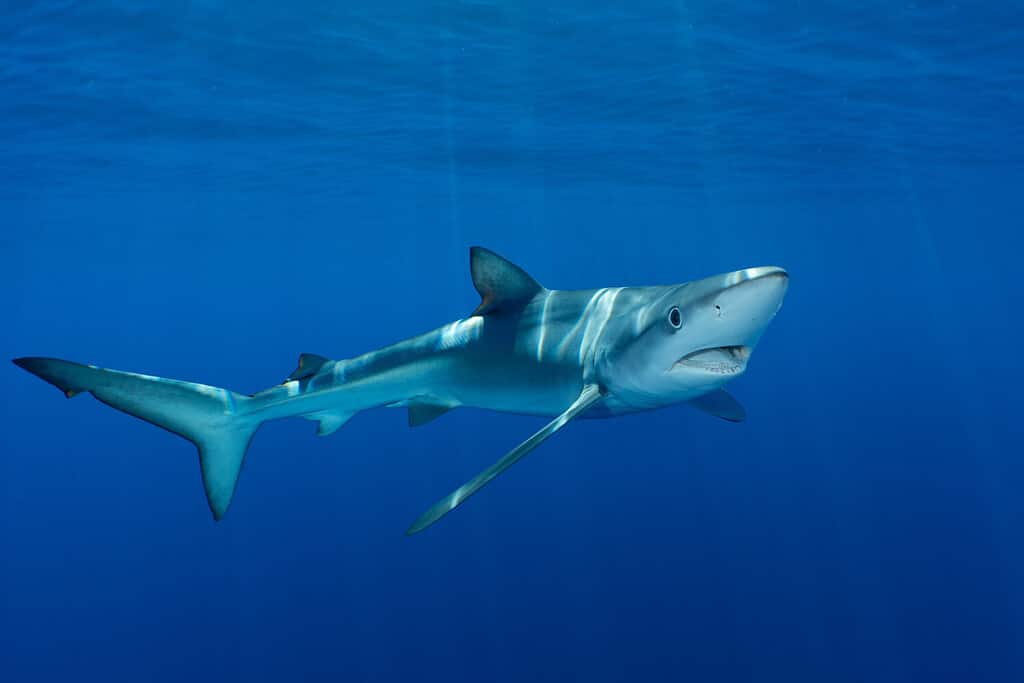
Blue sharks have a dark blue upper body, vibrant blue coloring on the sides, and a white belly.
©Samy Kassem/Shutterstock.com
It may come as a surprise since the name of the shark is blue shark, but it is not blue all the way. Its undersides are white in color and can be visibly seen from below.
But you will be interested to know they have quite a range of beautiful shades on their bodies. If you see them up close, they have a dark blue upper body, vibrant blue coloring on the sides, and a white belly. This streak of different colors helps the shark hide itself from its predators and sneak up on its prey.
#5 They Have a Violent Mating Behavior
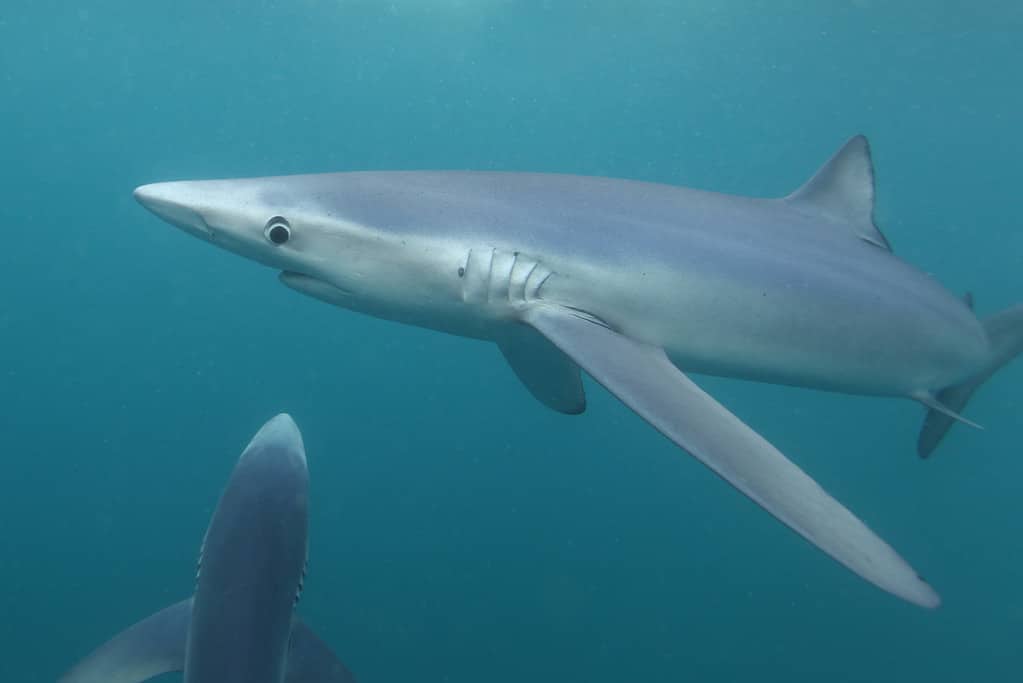
The female blue shark has three times tougher skin than that of a male blue shark.
©Alessandro De Maddalena/ via Getty Images
They are not as loving with their mating games as one would think. The female blue shark has three times tougher skin than that of a male blue shark. This is because the male bites the female quite a few times in order to mate. On top of that, the female blue shark is also longer and heavier than the male blue shark. It weighs as much as 400 pounds and can be as long as 10 feet long. In contrast, the male blue shark can be 9 feet long and weigh as much as 120 pounds.
#6 One of Their Predators is a Sea Lion
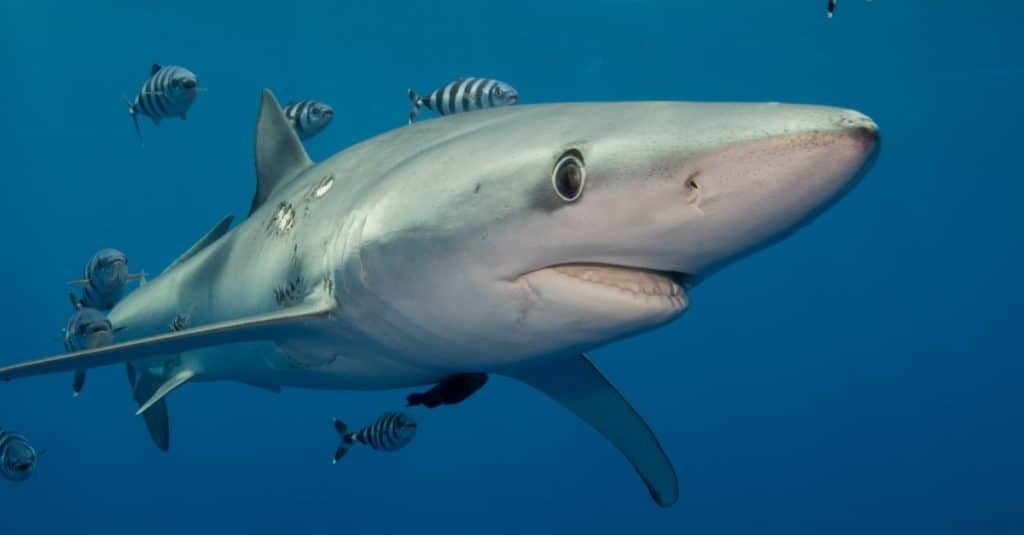
A parasite known as the tetraphyllidean tapeworm poses a threat to blue sharks.
©Jan Finsterbusch/Shutterstock.com
The blue shark attracts the bigger threats to the ocean like the Great White Shark or the Tiger Shark. But there are other predators that are quite small but pose a danger to the blue shark and its babies.
These include the sea lion and a parasite known as the tetraphyllidean tapeworm. The sea lions eat only the livers and stomachs of the blue shark but the parasites can cover up its gills, fins, and even noses. There can be as many as 3,000 parasites of different species living on this shark.
#7 They Live in Groups

One interesting thing to note here is that they have gender-based groups.
© Alessandro De Maddalena/ via Getty Images
This is quite obvious considering it is safer to travel in groups. With the idea that they migrate to larger distances to hunt, it is comparatively easier to do it with your companions right by your side. Blue Sharks do the same. And they often have a leader that is the largest animal in the group.
One interesting thing to note here is that they have gender-based groups. It will be either a female-dominant group or a male-dominant group. The groups of blue sharks are called schools.
#8 They Do Not Harm Humans

In the last few centuries, there have only been 20 attacks on humans by blue sharks and most of them were not life-threatening.
©Vladislav Klimin/Shutterstock.com
As they travel in groups, it can be scary to encounter them near the surface of the ocean. But they do not harm humans as much as humans harm them. Around 20 million blue sharks are hunted every year for their livers, fins, skins, and even for sports. This commercial use has put them on the list of near-threatened species.
In the last few centuries, there have only been a mere 20 attacks and most of them were not life-threatening. This is quite a low number considering the number of attacks by other sharks.
Having said that, it would be foolish to try and provoke them. If you want to know about their hunting tactics, they circle for around 15 minutes before they attack.
#9 They Can Be Seen Above The Ocean Sometimes

Although it is rare to find them playing above the ocean, they might be seen hunting the prey and doing aerobatics in order to catch them.
©Pommeyrol Vincent/Shutterstock.com
Like many other aquatic animals, it is a delightful sight to see them play above water. The blue shark is one of them.
Although it is rare to find them playing above the ocean, they might be seen hunting the prey and doing aerobatics in order to catch them. It is no surprise that they can go to great lengths to hunt and exposing themselves above the ocean is one of them.
#10 They Can Hear Your Heartbeat
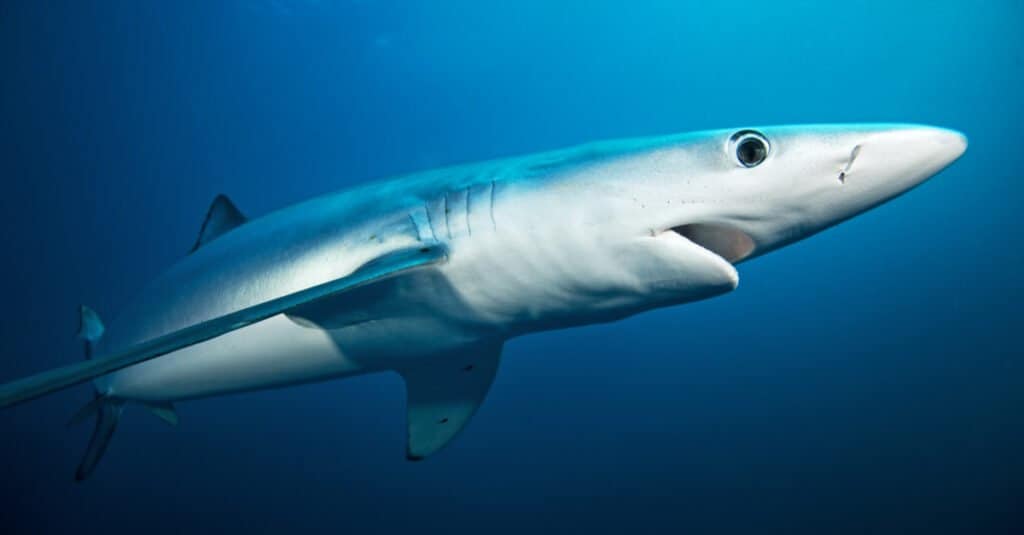
Though not aggressive, blue sharks are sometimes referred to as the “wolves of the sea,” perhaps because they travel at such high speeds.
©Martin Prochazkacz/Shutterstock.com
If you know about sharks, you would know that they have a special organ in their sensory system. It is called the ampullae of Lorenzini and is used widely by sharks for hunting.
The blue shark also has this organ but the interesting part is its function. It tracks the electromagnetic pulse of the prey and uses it to find and gobble the prey down. This pulse is generated by all living things and can help all sharks in finding their prey. The scary part is that even you can be located through the rhythmic beating of your heart.
The photo featured at the top of this post is © Martin Prochazkacz/Shutterstock.com
Sources
- Shark Sider, Available here: https://www.sharksider.com/blue-shark/
- Earth Touch News, Available here: https://www.earthtouchnews.com/oceans/sharks/top-10-things-you-should-know-about-blue-sharks/
- IP Factly, Available here: http://ipfactly.com/10-blue-shark-facts/
- Animals In Time, Available here: https://animalstime.com/blue-shark-facts-top-15-interesting-facts-about-blue-sharks/
- Kids Animals Facts, Available here: https://kidsanimalsfacts.com/blue-shark-facts-for-kids/
FAQs (Frequently Asked Questions)
Do blue sharks attack humans?
Although the blue shark is not considered to be aggressive, it is potentially dangerous to human beings and has been implicated in some unprovoked attacks.
What is special about blue sharks?
Blue sharks are known to be highly migratory, with individuals making several trips across entire ocean basins throughout their lifetimes. Experts believe that blue sharks use their large pectoral fins (horizontal fins growing out from either side of the body) to ride long currents, conserving energy as they migrate.
Are blue sharks going extinct?
The Blue Shark’s conservation status is “Near Threatened”
Thank you for reading! Have some feedback for us? Contact the AZ Animals editorial team.






